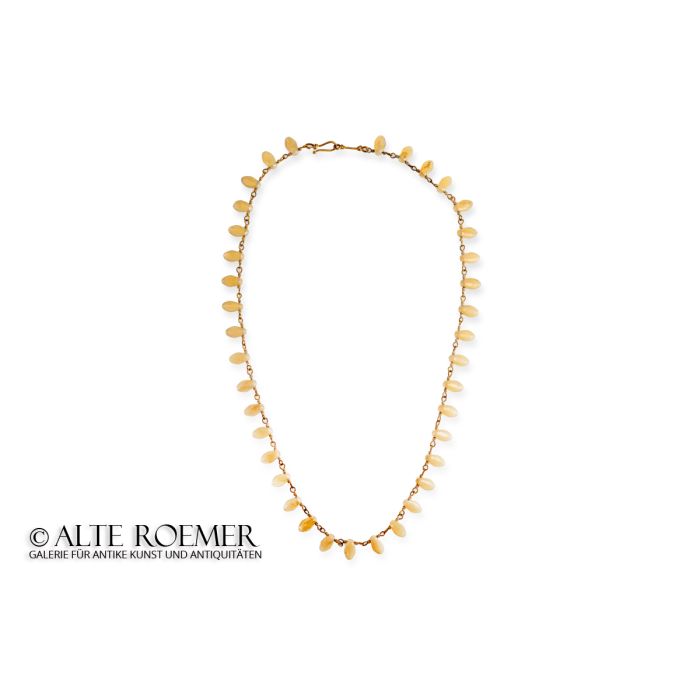Roman gold necklace with beads
€9,500
available
Object number
AR3485
| Object: |
Roman gold necklace with beads
|
| Material: |
Chain links made of gold. Beads made of beige, opaque stone, probably agate.
|
| Period: |
100 AD to 250 AD. Roman Imperial period. |
| Description: |
Roman necklace made of 40 dumbbell-shaped segments of gold wire. Each forms a small bar, the ends of which are bent into an eyelet, secured with a double wrap. 38 segments have a flat, teardrop-shaped agate bead threaded onto the wire bar. The other two segments form the clasp, with one segment bent into a hook at one end instead of the eyelet. The necklace is wonderfully preserved, including the original beads. It is likely that this piece comes from the Roman province of Moesia, or at least from southeastern Europe. Close comparison pieces listed below come from the Roman city of Ratiaria in Moesia, in modern-day Bulgaria, which was located near a gold mine. Necklaces of this type are known in local archaeology as the Hormoi type. |
| Dimensions: |
45cm long. The gemstones are each approximately 1cm long.
|
| Condition: |
Perfect condition, all chain links, gemstones and the clasp are original and intact. A magnificent specimen. Theoretically still wearable today.
|
| Provenance: |
Acquired by us in 2023 from the German private collection of Dr. Klaus Morkramer. Acquired by him in the 1960s or 1970s at the ancient art dealer Axel Weber from Cologne, Germany. Dr. Morkramer built a large collection of high-quality ancient artworks, with an academically motivated cross-section of bronzes, glasses, as well as jewellery and sculptures from the Greek and Roman period. The first part of his collection was sold in the 2000s and is now represented in well-known collections. For example, the glass vessel with inventory number 2007.233 in the Metropolitan Museum of Art. In the 2020s the final part of the Dr. Klaus Morkramer collection is offered by us. We feel priviledged to work with the artefacts and give them into the good care of a new owner. |
| References: |
Cf. L. Ruseva-Slokoska, Roman Jewellery, pp. 140, catalog nos. 99 and 101. The almost identical necklaces come from grave finds in Ratiaria, in the Roman province of Moesia, in present-day Bulgaria. Ruseva-Slokoska dates the pieces to the 2nd century to the middle of the 3rd century AD and calls them Hormoi type, a type designation for this type of necklace used in Roman archaeology in southeastern Europe. Cf. R. A. Higgins, Greek and Roman Jewellery, no. 57A. The piece is of a different design but similar workmanship. It comes from Tortosa in modern-day Syria and dates to the 2nd or 3rd century AD. For very similar necklaces on the art market, cf. Christie's New York, auction 13 December 2013, lot 311, sold for 11,875 USD. Cf. Christie's New York, auktion 7 December 2006, lot 286, sold for 10,200 USD. |
| Authenticity: |
We unconditionally guarantee the authenticity of every artefact, all items are subject to our lifetime return policy on authenticity.
|


